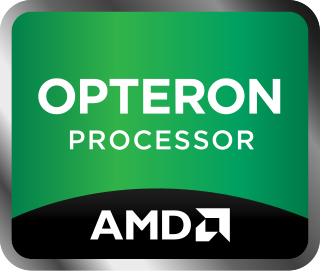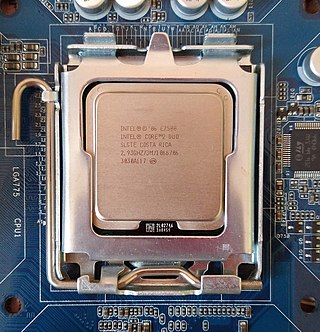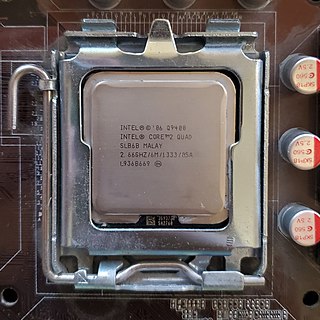Related Research Articles

Opteron is AMD's x86 former server and workstation processor line, and was the first processor which supported the AMD64 instruction set architecture. It was released on April 22, 2003, with the SledgeHammer core (K8) and was intended to compete in the server and workstation markets, particularly in the same segment as the Intel Xeon processor. Processors based on the AMD K10 microarchitecture were announced on September 10, 2007, featuring a new quad-core configuration. The last released Opteron CPUs are the Piledriver-based Opteron 4300 and 6300 series processors, codenamed "Seoul" and "Abu Dhabi" respectively.

Xeon is a brand of x86 microprocessors designed, manufactured, and marketed by Intel, targeted at the non-consumer workstation, server, and embedded markets. It was introduced in June 1998. Xeon processors are based on the same architecture as regular desktop-grade CPUs, but have advanced features such as support for error correction code (ECC) memory, higher core counts, more PCI Express lanes, support for larger amounts of RAM, larger cache memory and extra provision for enterprise-grade reliability, availability and serviceability (RAS) features responsible for handling hardware exceptions through the Machine Check Architecture (MCA). They are often capable of safely continuing execution where a normal processor cannot due to these extra RAS features, depending on the type and severity of the machine-check exception (MCE). Some also support multi-socket systems with two, four, or eight sockets through use of the Ultra Path Interconnect (UPI) bus, which replaced the older QuickPath Interconnect (QPI) bus.
The Intel QuickPath Interconnect (QPI) is a point-to-point processor interconnect developed by Intel which replaced the front-side bus (FSB) in Xeon, Itanium, and certain desktop platforms starting in 2008. It increased the scalability and available bandwidth. Prior to the name's announcement, Intel referred to it as Common System Interface (CSI). Earlier incarnations were known as Yet Another Protocol (YAP) and YAP+.
In the fields of digital electronics and computer hardware, multi-channel memory architecture is a technology that increases the data transfer rate between the DRAM memory and the memory controller by adding more channels of communication between them. Theoretically, this multiplies the data rate by exactly the number of channels present. Dual-channel memory employs two channels. The technique goes back as far as the 1960s having been used in IBM System/360 Model 91 and in CDC 6600.
The Intel Core microarchitecture is a multi-core processor microarchitecture launched by Intel in mid-2006. It is a major evolution over the Yonah, the previous iteration of the P6 microarchitecture series which started in 1995 with Pentium Pro. It also replaced the NetBurst microarchitecture, which suffered from high power consumption and heat intensity due to an inefficient pipeline designed for high clock rate. In early 2004 the new version of NetBurst (Prescott) needed very high power to reach the clocks it needed for competitive performance, making it unsuitable for the shift to dual/multi-core CPUs. On May 7, 2004 Intel confirmed the cancellation of the next NetBurst, Tejas and Jayhawk. Intel had been developing Merom, the 64-bit evolution of the Pentium M, since 2001, and decided to expand it to all market segments, replacing NetBurst in desktop computers and servers. It inherited from Pentium M the choice of a short and efficient pipeline, delivering superior performance despite not reaching the high clocks of NetBurst.

Pentium is a discontinued series of x86 architecture-compatible microprocessors produced by Intel. The original Pentium was first released on March 22, 1993. The name "Pentium" is originally derived from the Greek word pente (πεντε), meaning "five", a reference to the prior numeric naming convention of Intel's 80x86 processors (8086–80486), with the Latin ending -ium since the processor would otherwise have been named 80586 using that convention.

LGA 771, also known as Socket J, is a CPU interface introduced by Intel in 2006. It is used in Intel Core microarchitecture and NetBurst microarchitecture (Dempsey) based DP-capable server processors, the Dual-Core Xeon is codenamed Dempsey, Woodcrest, and Wolfdale and the Quad-Core processors Clovertown, Harpertown, and Yorkfield-CL. It is also used for the Core 2 Extreme QX9775, and blade servers designated under Conroe-CL.

Nehalem is the codename for Intel's 45 nm microarchitecture released in November 2008. It was used in the first generation of the Intel Core i5 and i7 processors, and succeeds the older Core microarchitecture used on Core 2 processors. The term "Nehalem" comes from the Nehalem River.

LGA 1366, also known as Socket B, is an Intel CPU socket. This socket supersedes Intel's LGA 775 in the high-end and performance desktop segments. It also replaces the server-oriented LGA 771 in the entry level and is superseded itself by LGA 2011. This socket has 1,366 protruding pins which touch contact points on the underside of the processor (CPU) and accesses up to three channels of DDR3 memory via the processor's internal memory controller.

Phenom II is a family of AMD's multi-core 45 nm processors using the AMD K10 microarchitecture, succeeding the original Phenom. Advanced Micro Devices released the Socket AM2+ version of Phenom II in December 2008, while Socket AM3 versions with DDR3 support, along with an initial batch of triple- and quad-core processors were released on February 9, 2009. Dual-processor systems require Socket F+ for the Quad FX platform. The next-generation Phenom II X6 was released on April 27, 2010.
Gulftown or Westmere-E is the codename of an up to six-core hyperthreaded Intel processor able to run up to 12 threads in parallel. It is based on Westmere microarchitecture, the 32 nm shrink of Nehalem. Originally rumored to be called the Intel Core i9, it is sold as an Intel Core i7. The first release was the Core i7 980X in the first quarter of 2010, along with its server counterpart, the Xeon 3600 and the dual-socket Xeon 5600 (Westmere-EP) series using identical chips.

Conroe is the code name for many Intel processors sold as Core 2 Duo, Xeon, Pentium Dual-Core and Celeron. It was the first desktop processor to be based on the Core microarchitecture, replacing the NetBurst microarchitecture based Cedar Mill processor. It has product code 80557, which is shared with Allendale and Conroe-L that are very similar but have a smaller L2 cache. Conroe-L has only one processor core and a new CPUID model. The mobile version of Conroe is Merom, the dual-socket server version is Woodcrest, the quad-core desktop version is Kentsfield and the quad-core dual-socket version is Clovertown. Conroe was replaced by the 45 nm Wolfdale processor.

Penryn is the code name of a mobile processor from Intel that is sold in varying configurations such as Core 2 Solo, Core 2 Duo, Core 2 Quad, Pentium and Celeron.

Wolfdale is the code name for a processor from Intel that is sold in varying configurations as Core 2 Duo, Celeron, Pentium and Xeon. In Intel's Tick-Tock cycle, the 2007/2008 "Tick" was Penryn microarchitecture, the shrink of the Merom microarchitecture to 45 nanometers as CPUID model 23. This replaced the Conroe processor with Wolfdale.

Yorkfield is the code name for some Intel processors sold as Core 2 Quad and Xeon. In Intel's Tick-Tock cycle, the 2007/2008 "Tick" was Penryn microarchitecture, the shrink of the Core microarchitecture to 45 nanometers as CPUID model 23, replacing Kentsfield, the previous model.
Lynnfield is the code name for a quad-core processor from Intel released in September 2009. It was sold in varying configurations as Core i5-7xx, Core i7-8xx or Xeon X34xx. Lynnfield uses the Nehalem microarchitecture and replaces the earlier Penryn based Wolfdale and Yorkfield processors, using the same 45 nm process technology, but with a new memory and bus interface. The product code for Lynnfield is 80605, its CPUID value identifies it as family 6, model 30 (0106Ex).

Intel Core is a line of multi-core central processing units (CPUs) for midrange, embedded, workstation, high-end and enthusiast computer markets marketed by Intel Corporation. These processors displaced the existing mid- to high-end Pentium processors at the time of their introduction, moving the Pentium to the entry level. Identical or more capable versions of Core processors are also sold as Xeon processors for the server and workstation markets.

LGA 2011, also called Socket R, is a CPU socket by Intel released on November 14, 2011. It launched along with LGA 1356 to replace its predecessor, LGA 1366 and LGA 1567. While LGA 1356 was designed for dual-processor or low-end servers, LGA 2011 was designed for high-end desktops and high-performance servers. The socket has 2011 protruding pins that touch contact points on the underside of the processor.

Broadwell is the fifth generation of the Intel Core processor. It is Intel's codename for the 14 nanometer die shrink of its Haswell microarchitecture. It is a "tick" in Intel's tick–tock principle as the next step in semiconductor fabrication. Like some of the previous tick-tock iterations, Broadwell did not completely replace the full range of CPUs from the previous microarchitecture (Haswell), as there were no low-end desktop CPUs based on Broadwell.
References
- 1 2 3 "Intel Core i7-920 Processor (8M Cache, 2.66 GHz, 4.80 GT/s Intel QPI)". Intel. Retrieved 6 December 2008.
- 1 2 3 "Intel Core i7-940 Processor (8M Cache, 2.93 GHz, 4.80 GT/s Intel QPI)". Intel. Retrieved 6 December 2008.
- 1 2 3 4 5 "Intel Core i7-965 Processor Extreme Edition (8M Cache, 3.20 GHz, 6.40 GT/s Intel QPI)". Intel. Retrieved 6 December 2008.
- ↑ Tech paper intel.com [ dead link ]
- ↑ "CPU-Z Validator 3.1".
- ↑ "Core i7 975 review". Guru3D.com. Archived from the original on 27 March 2012. Retrieved 23 September 2009.
- 1 2 "Intel Core i7 Processor Extreme Edition and Intel Core i7 Processor Datasheet, Volume 1" (PDF). Intel. 4 November 2008. Retrieved 29 May 2009.
- ↑ "Box codes". 16 September 2008. Archived from the original on 23 July 2012. Retrieved 23 September 2009.
- 1 2 Worrel, Jon (9 February 2009). "Core i7 950 and 975 to replace 940 and 965". Fudzilla. Archived from the original on 30 March 2009. Retrieved 10 February 2009.
- ↑ Hagedoorn, Hilbert (16 June 2009). "Intel to launch new Core i7 960 and Celerons on the 18th of october". Guru3d. Retrieved 16 June 2009.
- ↑ "New Core i7 975 Extreme Edition Surfaces". techPowerUp. Archived from the original on 8 February 2009. Retrieved 10 February 2009.
- ↑ "Core i7 965 XE Races Through to 4.20 GHz".
- ↑ Nguyen, Tuan (9 July 2008). "'Nehalem' 2.93 GHz Benches Revealed". Tom's Hardware. Archived from the original on 17 February 2012. Retrieved 23 September 2009.
- ↑ "Tom's Hardware: Desktop CPU Charts Q3/2008: 3d Mark Vantage - CPU". Tom's Hardware. 5 November 2008. Archived from the original on 5 February 2013.
- ↑ "Intel does it again". AnandTech. 5 June 2008.
- ↑ "Retail Core i7 CPUs More Powerful than Originally Reported". Maximum PC. 4 March 2009.
- ↑ "First Look at Core i7-975 XE: D0 Processor Stepping in Action". X-bit labs. 21 April 2009. Archived from the original on 5 May 2009. Retrieved 23 September 2009.
- ↑ "Intel Core i7 975 Extreme Edition Processor Review - Page 10". 3 June 2009. Archived from the original on 6 June 2009. Retrieved 23 September 2009.
- ↑ "Core i7 sees new WR at 5510MHz on Rampage II". 2 December 2008.
- ↑ Taylor, Paul (3 October 2008). "Performance RAM will damage your Nehalem". The Inquirer. Archived from the original on 4 October 2008. Retrieved 4 October 2008.
{{cite web}}: CS1 maint: unfit URL (link) - ↑ Supermicro's C7X58 and X8SAX Supermicro's X8SAX page
- ↑ "P6T6 WS Revolution". Archived from the original on 10 October 2010. Retrieved 23 September 2009.
- ↑ "Intel's Core i7 965 EE, 940 To See EOL in September". VR-Zone. 7 May 2009. Archived from the original on 8 May 2009. Retrieved 14 July 2009.
- ↑ Intel's Discontinuation notice for 965XE Archived May 30, 2009, at the Wayback Machine
- ↑ Intel's discontinuation notice for 940 Archived May 30, 2009, at the Wayback Machine
- ↑ "Intel updates CPU phase-out schedule; to skip Havendale and go directly to Clarkdale". 18 June 2009.